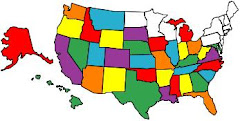Yukon Territory
The population is 31.608. The Yukon Territory covers about 186,272 square miles or about the size of California. The Capital is Whitehorse with a population of 24,041. As you can see there aren't very many people in the other parts of the Territory. You can dive for hours and hours and never see a house, power poles or any sign of civilization. You do of course see quite a few animals.
The Yukon is bordered on the west by Alaska, on the north by the Beaufort Sea/Arctic Ocean, on the south by British Columbia and on the east by the Northwest Territories.
The indigenous peoples of the Yukon are referred to as First Nations. These aboriginal groups are Gwich'in, Han, Northern Tutchone, Southern Tutchone, Kaska, Tagish, Tingit and Upper Tanana. Their habitation is believed to date back about 50,000 years.
The Yukon was made a district of the Northwest Territories is 1895, and became a separate territory in June of 1898.
Some of you may remember years ago a radio program called "Sgt. Preston of the Yukon and his wonder dog King". This territory was where it was all about. The North West Mounted Police, now called Royal Canadian Mounted Police are still here and they are the main law enforcement body in the Territory.
Whitehorse is the Capital of the Yukon and is a hub of a network of about 2,664 miles of all-weather roads serving the Yukon Territory. About two-thirds of the population of the Yukon live in Whitehorse. It's the only large or even big city in the entire Territory.
Whitehorse sits on the banks of the Yukon River and is right next to the Whitehorse rapids. The city got it's name from the first miners in the Territory that believed foaming rapids resembled white horses' manes and so named the river rapids.
If you're traveling across Canada into Alaska, then the City of Whitehorse is indeed a stop to be made and not just over night but for several days in order to see all the old famous sites here.
Wednesday, August 5, 2009
Subscribe to:
Post Comments (Atom)


No comments:
Post a Comment